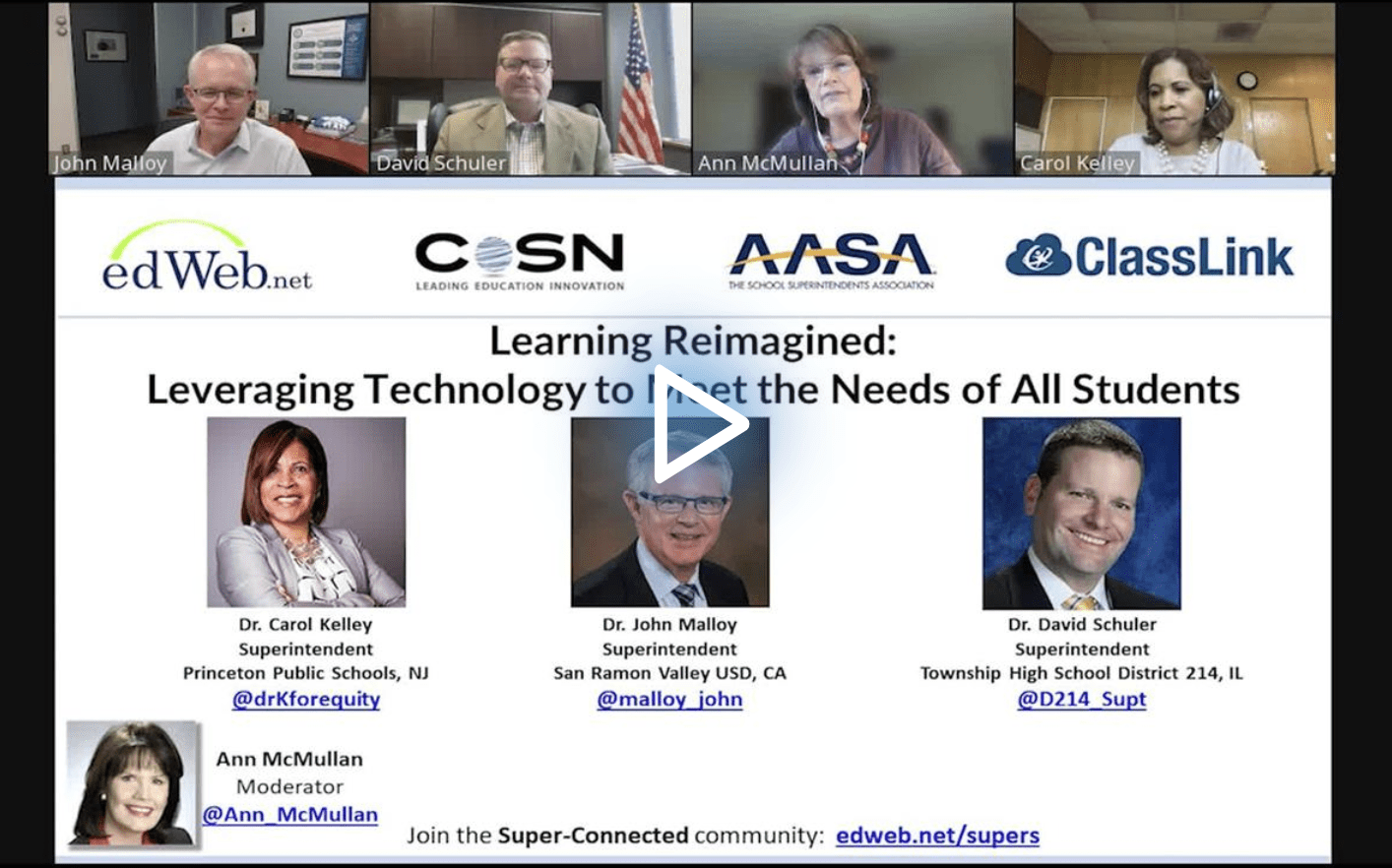The Technological Transformation of Districts to Benefit All Learners
Blog post by Robert Low based on this edWebinar
Many school districts are now going through a process of determining which pandemic-related practices should be kept, improved, or discarded, and the use of remote and blended learning technologies is frequently being raised during these types of discussions.
Insights into the successes and challenges of using educational technology in an effective and equitable way were discussed during a recent edWebinar, sponsored by ClassLink and co-hosted by CoSN and AASA. The presentation featured Dr. Carol Kelley, Superintendent of the Princeton Public Schools (NJ); Dr. John Malloy, Superintendent of the San Ramon Valley Unified School District (CA); and Dr. David Schuler, Superintendent of High School District 214 (IL).
Curriculum, Instruction, and Assessment
Equal access to online learning opportunities has continued to be a challenge, with the focus expanding beyond access to devices and hotspots and now including high-speed access for all students. Dr. Schuler explained that his district used boosters on water towers to make sure students who are living and learning in trailer parks and low-cost apartment complexes could work and progress at the same speed as students in affluent suburban homes.
Assessment of students has also been transformed in many cases, with a greater emphasis on students’ social-emotional well-being and behavioral characteristics, in addition to their academic achievement. Educators have been visiting small-group breakout rooms online to see how students are engaging with the curriculum material and other students, and using educational technology to focus on individual students’ faces rather than trying to observe an entire class of 25 or 30 students at once.
Improving the use of the various types of assessment data is another priority. Using formative assessment data throughout the year remains crucial for guiding instruction, and as Dr. Kelley pointed out, it can and should be used for referrals to Multi-Tiered Systems of Support as well. This trend is also reflected in Dr. Schuler turning his districts’ problem-solving teams into solution-finding teams, as part of an effort to “catch kids when they start to lean rather than when they fall.”
A proactive approach can also be used in regard to blended learning, which Dr. Kelley described as having been brought to a level of choice that hadn’t traditionally been seen because it provides more access to the curriculum and to opportunities to learn in different ways and at different times. Dr. Malloy now sees blended learning as a design strategy and opportunity where “choice and voice are more present,” though the use of online technologies also revealed that some educators need more support in order to use the technologies effectively.
Professional Learning, Family Connections, and Community Engagement
Support and professional learning for staff members have been transformed by some of the same online technologies that have proved challenging for educators to use during the pandemic. Dr. Schuler noted a decreased need to have everyone come to a single location for a meeting or training session, which in turn decreased the need to pay for substitute teachers. He also found that blended learning can be a great way to maximize the learning potential of parents as well as educators and students.
His district used social media and “micro-campaigns” to provide messaging to parents about ways to support their children academically and in other ways, and his district found virtual parent-teacher conferences and career nights had much more attendance than in-person events. Dr. Malloy’s district experienced a three-fold increase in parent participation due to the availability of online technologies, which decreased the need for parents to leave their children at home.
He used the increased online access to provide strategic direction for his district, engaging more than 8,000 stakeholders in the process through virtual focus groups and town halls, and crowd-sourcing technologies. He also emphasized the importance of establishing norms in regard to behavior online, because students and adults have all been jettisoned into a digital world for which they are not equally prepared.
Diversity, Inclusion, and Equity
Dr. Schuler sees online technologies as a way to ensure that “no learner is marginalized,” with access to courseware becoming another moral imperative that will prevent students from being denied a full and fair education.
Dr. Kelley emphasized the importance of educators using technology to listen to students through focus groups and develop information that includes students’ lived experiences, which can then be used to create more responsive communities.
For Dr. Malloy, online technologies are increasing the opportunities to have direct conversations and compile data that can bring about accountability and change in order to move beyond intent and actually have a positive impact.
This edWeb broadcast was sponsored by ClassLink and co-hosted by CoSN and AASA.
Watch the Recording Listen to the Podcast
About the Presenters
Dr. Carol L. Kelley is Superintendent of Princeton Public Schools, NJ. Prior to joining PPS, Dr. Kelley spent six years as Superintendent of Oak Park Elementary School District 97, IL, and three years as Superintendent in the Branchburg Township School District, NJ. She has also held teaching, administrator and superintendent positions in New Jersey and Pennsylvania.
Dr. Kelley’s career is guided by her deep commitment to equity-centered systems change to address racial, economic, and academic disparities in education. She is a thought-leader and speaker for several organizations and has received recognition for her professional work and contributions to education from various organizations and groups, including the prestigious Governor’s Teacher award from the state of New Jersey. Dr. Kelley received her bachelor’s degree in systems engineering and doctorate in education from University of Pennsylvania. She also holds an MBA from the Darden School of Business at the University of Virginia.
Dr. John Malloy came to the San Ramon Valley Unified School District after having served as Director of Education (Superintendent) at the Toronto District School Board, Toronto, Canada which is the largest school board in Canada and the eighth largest school board in North America. Dr. Malloy has an extensive background in education at all levels and is a fierce advocate for equitable, accessible, quality public education. He brings a vision for learning that emphasizes the importance of collaboration and engagement. He believes that we have a responsibility to ensure that every student feels connected and engaged in their learning.
By strengthening relationships and continuing to build partnerships among students, staff, families and communities, student needs are supported, and learning and well-being will improve. Dr. Malloy believes that together we can build positive school and workplace cultures that support mental health and well-being, are free of bias and full of potential.
Dr. David R. Schuler is the 2018 Illinois and National Superintendent of the Year. Known for his ability to inspire and build leaders, he spearheaded Redefining Ready!, the national movement to redefine what it means for students to be college, career and life ready while serving as the 2015-2016 President of AASA, The School Superintendents Association.
Dr. Schuler has served 21 years as a superintendent, 16 of them currently leading High School District 214, Illinois’ largest high school district. There, he’s led the development of an innovative instructional philosophy around personalized learning experiences focused on career pathways, early college credit, and industry credentials that enable students to discover their futures while still in high school. Dr. Schuler earned his bachelor’s degree from Carroll University and his master’s and doctoral degrees from the University of Wisconsin-Madison.
About the Host
Ann McMullan is Project Director for CoSN’s EmpowerED Superintendents Initiative. Ann served as Executive Director for Educational Technology in Klein ISD, near Houston, Texas until September 2013, when she and her family moved to Los Angeles, California. For 16 years Ann led the district team that provided professional development on technology and 21st century instructional strategies to 4,000 educators serving 50,000 students. She was co-chair of the Texas Education Technology Advisory Committee which developed the Texas Long Range Plan for Technology.
Today, Ann works as a public speaker, writer, and education consultant focused on leadership to meet the needs of today’s students. Ann serves on the edWeb.net Advisory Board, ClassLink’s Senior Advisors Group, and is a founding member of ERDI’s Ed Leadership Council. She also volunteers as a leadership consultant with Executive Service Corps of Southern California, serving non-profit associations. Ann is the co-author of Life Lessons in Leadership, available on Amazon.com.
Join the Community
Super-Connected is a free professional learning community on edWeb.net for school superintendents, district leadership, and aspiring district leaders.








Comments are closed.